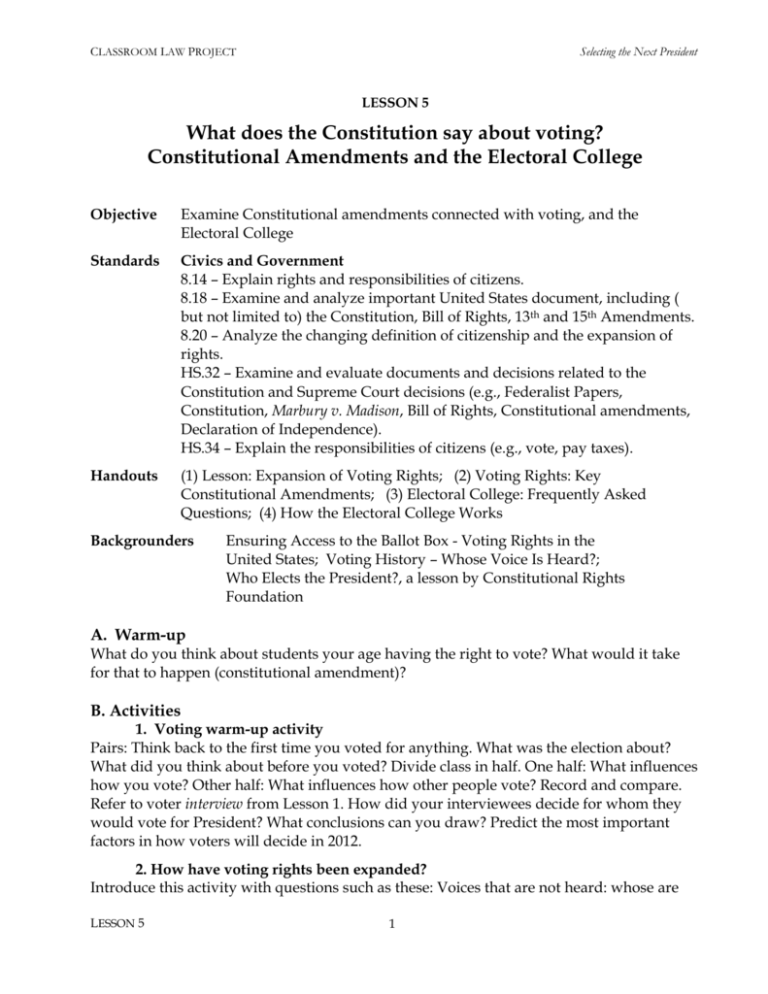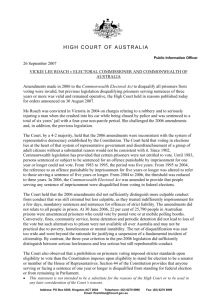01-L5-Constitution-and-Voting
advertisement

CLASSROOM LAW PROJECT Selecting the Next President LESSON 5 What does the Constitution say about voting? Constitutional Amendments and the Electoral College Objective Examine Constitutional amendments connected with voting, and the Electoral College Standards Civics and Government 8.14 – Explain rights and responsibilities of citizens. 8.18 – Examine and analyze important United States document, including ( but not limited to) the Constitution, Bill of Rights, 13th and 15th Amendments. 8.20 – Analyze the changing definition of citizenship and the expansion of rights. HS.32 – Examine and evaluate documents and decisions related to the Constitution and Supreme Court decisions (e.g., Federalist Papers, Constitution, Marbury v. Madison, Bill of Rights, Constitutional amendments, Declaration of Independence). HS.34 – Explain the responsibilities of citizens (e.g., vote, pay taxes). Handouts (1) Lesson: Expansion of Voting Rights; (2) Voting Rights: Key Constitutional Amendments; (3) Electoral College: Frequently Asked Questions; (4) How the Electoral College Works Backgrounders Ensuring Access to the Ballot Box - Voting Rights in the United States; Voting History – Whose Voice Is Heard?; Who Elects the President?, a lesson by Constitutional Rights Foundation A. Warm-up What do you think about students your age having the right to vote? What would it take for that to happen (constitutional amendment)? B. Activities 1. Voting warm-up activity Pairs: Think back to the first time you voted for anything. What was the election about? What did you think about before you voted? Divide class in half. One half: What influences how you vote? Other half: What influences how other people vote? Record and compare. Refer to voter interview from Lesson 1. How did your interviewees decide for whom they would vote for President? What conclusions can you draw? Predict the most important factors in how voters will decide in 2012. 2. How have voting rights been expanded? Introduce this activity with questions such as these: Voices that are not heard: whose are LESSON 5 1 CLASSROOM LAW PROJECT Selecting the Next President they? Why are they not heard and what difference does it make to voting as an expression of democracy? From Handout 1, Lesson Expansion of Voting Rights, this excellent lesson from the American Bar Association is designed as an introductory activity where students get an overview of the historical development of voting rights. By examining the expansion of the right to vote, the activity highlights the U.S. Constitution as a living document. Eight of the seventeen amendments adopted since the ratification of the Bill of Rights have involved voting rights. Numerous Supreme Court decisions as well as federal legislation, most notably the Voting Rights Act, have attempted to break down barriers to voting. In addition, the activity provides students with the opportunity to begin exploring what the right to vote means in America. See backgrounders Ensuring Access to the Ballot Box – Voting Rights in the United States, and Voting History – Whose Voice is Heard for more information. 3. What do the amendments say? Distribute Handout 2, Voting Rights: Key Constitutional Amendments. Teachers may want to do a class read aloud of all the amendments on the handout. Ask students to look for trends or for groups that are missing. Divide class into five groups. Ask each group to present the voting amendments to the rest of the class. Why do these amendments matter? Rank them as to importance. Create a timeline. Options: focusing on one amendment, create newspaper headlines, do a skit, create a song or rap. 4. May I attend the Electoral College? What is the electoral college? How is the president really elected? Why do we have the electoral college? Should we, could we change? See Handout 3, Electoral College Frequently Asked Questions, for information including that which is specific to Oregon. For a brief description of the electoral college, see: http://www.abanet.org/publiced/youth/sia/voting/electoralinfo.html For a great graphic depiction of how the electoral college works, see Handout 4 excerpted from a lesson by the Washington Post. An excellent lesson on counting electoral votes by Constitutional Rights Foundation is reprinted with permission in its entirety in the backgrounders. Students analyze actual voting data from 1992, 1996, 2000, and 2004. The numbers in the tables may look daunting at first but, on closer look, it is fascinating. Every number represents people voting for the candidate they believe will do the best job as President. So students should have fun with the numbers and see what they can learn. This lesson may also be found at www.lawanddemocracy.org/pdffiles/Who%20Elects%20the%20President.pdf. D. Extended Activities Homework / Journal/Weblog Entry LESSON 5 2 CLASSROOM LAW PROJECT Selecting the Next President If you could propose a constitutional amendment related to voting, what would it be? Describe why. Choose a voting topic that interests you and frame three questions you would like answered. Investigate felons’ right to vote. Find out what Oregon’s law is regarding convicted felons' right to vote. Discuss whether a person who pays his or her debt to society should be allowed to vote. Does the kind of crime a person was convicted of affect your opinion? See: www.abanet.org/publiced/youth/sia/voting/action_voice.html. Research voting in other countries. Constitutional Rights Foundation’s website is a treasure trove of materials for teachers. See www.crf-usa.org, specifically a lesson on voter fraud with solid background information (http://www.crf-usa.org/bill-of-rights-in-action/bria-24-2-b-making-it-easierto-vote-vs-guarding-against-election-fraud). Resources for higher-level classes: http://avalon.law.yale.edu/18th_century/amend1.asp. This site provides a comprehensive list of Constitutional provisions related to voting. It lists Amendments 11 through 27 without commentary. For commentary and context go to: www.usconstitution.net/constamnotes.html . LESSON 5 3





